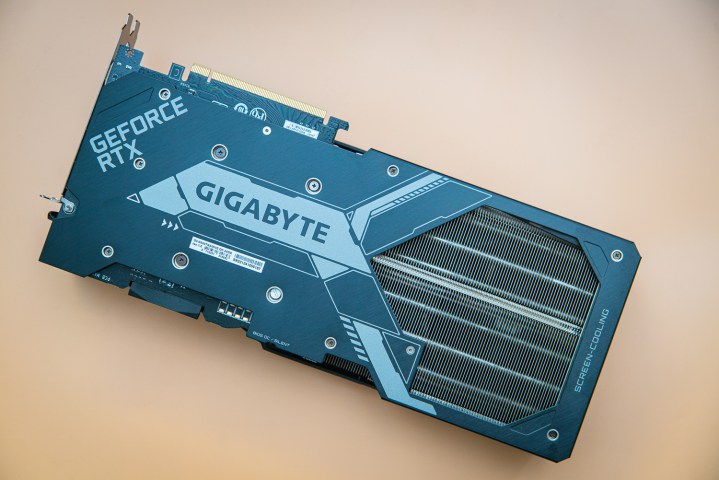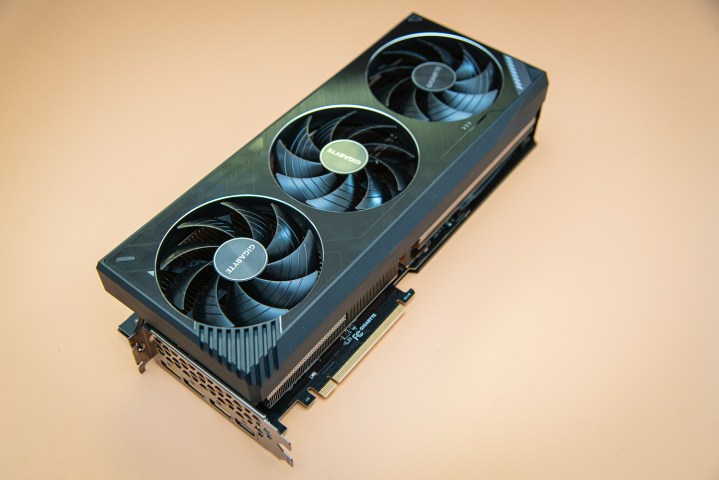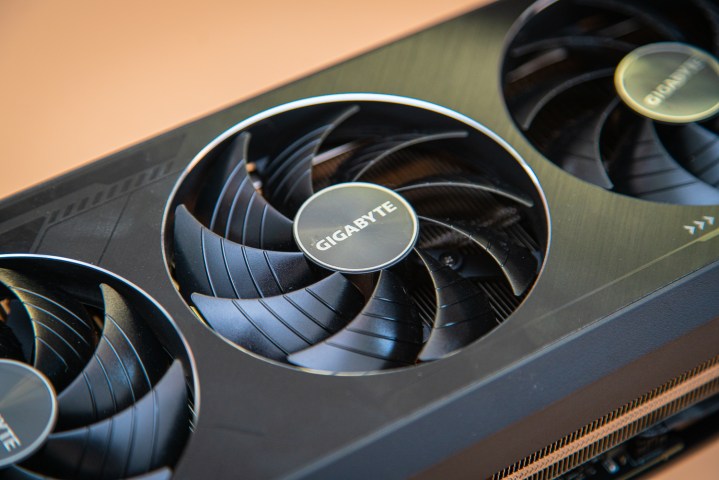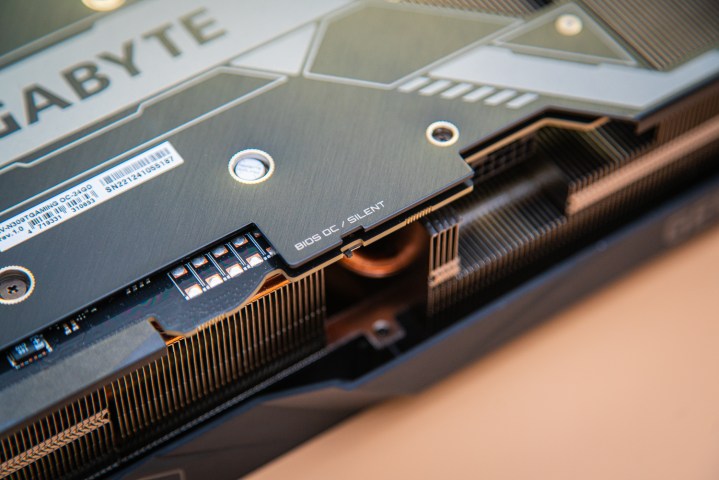“It's hot and it draws a lot of power, but the Gigabyte GeForce RTX 3090 Ti Gaming OC offers the best performance out of any GPU you can buy.”
- The fastest GPU you can buy
- Excellent 4K and ray tracing gaming performance
- Solid cooling solution
- Minimal fan noise
- Dual BIOS switch
- Draws a lot of power
- Very expensive
- Massive
But why?
That was the collective question that rippled through the PC enthusiast crowd when the RTX 3090 Ti was originally announced. Nvidia already had the best graphics card you could buy with the RTX 3090, and the spec sheet suggested that it was nothing more than a marketing ploy.
But Gigabyte’s GeForce RTX 3090 Ti Gaming OC proves that assumption wrong. Don’t get me wrong — it’s monstrously large, absurdly expensive, and ungodly power-hungry. But if you’re on a quest to unlock the highest performance possible out of a gaming PC, this is the graphics card you’ve always wanted.
Specs and pricing

The Gigabyte RTX 3090 Ti Gaming OC falls in line with Gigabyte’s previous offerings in this range. You’re looking at a slight 2.4% increase in the max boost clock speed over the reference design, which is a small but notable difference. Otherwise, the difference comes down to the cooler and size.
| Gigabyte RTX 3090 Ti Gaming OC | RTX 3090 Ti reference | RTX 3090 reference | |
| CUDA cores | 10,752 | 10,752 | 10,496 |
| Boost clock | 1,905MHz | 1,860MHz | 1,695MHz |
| Memory | 24GB GDDR6X | 24GB GDDR6X | 24GB GDDR6X |
| Memory bus | 384-bit | 384-bit | 384-bit |
| Effective bandwidth | 1,008 GB/s | 1,008 GB/s | 936.2 GB/s |
| Interface | PCIe 4.0 x16 | PCIe 4.0 x16 | PCIe 4.0 x16 |
| Size (LxWxH) | 331mm x 150mm x 70mm | 336mm x 140mm x 61mm | 336mm x 140mm x 61mm |
| TDP | 450W | 450W | 350W |
| Recommended PSU | 850W | 850W | 750W |
It’s a comically large graphics card, clocking in at 10mm wider and 9mm thicker than even Nvidia’s massive reference design. Gigabyte puts the space to good use with three 100mm fans and an extended heat sink, which allows air to pass straight through the cooling apparatus beyond the PCB and backplate.
Performant as it is, the Gigabyte RTX 3090 Ti Gaming OC doesn’t look great. It’s flat black, which is made all the worse considering this is the only RTX 3090 Ti design Gigabyte offers (even from its Aorus brand).
It’s not sleek; it’s boring. This card could look great in certain builds, but I imagine most gamers will opt for something like the EVGA FTW3 or MSI Suprim X editions simply because they’re flashier.

The main difference is price. Gigabyte’s model sells for as low as $2,000, while models like the EVGA FTW3 Ultra climb closer to $2,200. That’s the range for new, in-stock cards, however. Now, $200 is $200, but it’s not a huge difference considering how much the RTX 3090 Ti costs.
For the RTX 3090 Ti overall, it’s one hungry graphics card. It has about a 10% boost in clock speed over the base model, along with a slight bump to core count and memory frequency. That comes with a staggering 100-watt overhead, bringing the TDP up to 450W.
Nvidia only recommends an 850W power supply, which is a little concerning. I wouldn’t use the RTX 3090 Ti with anything less than a 1,000W PSU (read our roundup of the best PC power supplies if you need an upgrade).
Gaming

The RTX 3090 Ti is shockingly good for gaming, and Gigabyte’s Gaming OC edition pushes it even further. Overall, the card was 9.8% faster in my benchmarks over the RTX 3090 reference design, and a full 13.2% faster than the RTX 3080 Ti at 4K with Ultra settings. If you want the gritty details, you can see my full results in the table below.
I ran all of my tests with a Core i9-10900K and 32GB of DDR4-3200 memory. I only included results at 4K here because, let’s be honest, you’re not buying an RTX 3090 Ti to not play at 4K. Still, I was surprised to see a difference in some games even at 1080p, including a 8.5% boost in Red Dead Redemption 2 and 7.2% increase in Assassin’s Creed Valhalla.
The RTX 3090 Ti cements itself as the most powerful GPU you can buy.
Clearly, the RTX 3090 Ti hits a gaming mark that the RTX 3090 didn’t. For over a year now, I’ve been pushing gamers toward the RTX 3080 Ti over the RTX 3090 because it’s much cheaper and performs about the same. The RTX 3090 Ti, especially Gigabyte’s Gaming OC variant, makes a compelling argument to buy a flagship for gaming.
| RTX 3090 Ti | RTX 3090 | |
| 3DMark Time Spy | 19,848 | 18,341 |
| Red Dead Redemption 2 | 84 fps | 77 fps |
| Fortnite | 86 fps | 69 fps |
| Assassin’s Creed Valhalla | 72 fps | 63 fps |
| Forza Horizon 4 | 147 fps | 158 fps |
| Cyberpunk 2077 | 49 fps | 46 fps |
| Cyberpunk 2077 w/ RT | 24 fps | 21 fps |
Getting down to specifics, the RTX 3090 Ti offered a sizable boost in performance over the RTX 3090 in all of my tests except Forza Horizon 4. Across resolutions, the RTX 3090 consistently outperformed its more expensive Ti variant here.
Even so, the RTX 3090 Ti is remarkable. It’s the first card to crack 70 frames per second (fps) in Assassin’s Creed Valhalla, and it even got close to 60 fps in Cyberpunk 2077 with everything maxed out.

That performance scaled with ray tracing turned on, offering a massive 14% increase in Cyberpunk 2077 over the base model. You would want to turn on Nvidia’s Deep Learning Super Sampling (DLSS), but this demanding test shows how the RTX 3090 Ti can still offer real benefits in games.
That was my main concern — the RTX 3090 is already a card made for professionals, not gamers, so I figured the Ti model wouldn’t offer a big boost. It does. That 10% boost in clock speed translates into about a 10% boost in games, far outpacing the competition and cementing the RTX 3090 Ti as the most powerful GPU you can buy.
Content creation

I focused less on content creation benchmarks because the RTX 3090 is already the champion here. Frankly, 24GB of RAM and Nvidia’s proprietary rendering technologies dominate the industry, so I focused mainly on a stressful GPU workload through Blender to see how the Ti model would scale.
| RTX 3090 Ti | RTX 3090 | |
| PugetBench for Premiere Pro – GPU score | 92.7 | 93.1 |
| Blender Classroom | 1,691 | 1,394 |
| Blender Monster | 2,962 | 2,826 |
| Blender Junkshop | 1,467 | 1,615 |
Across the three renders in Blender’s 3.0 Open Data benchmark, the RTX 3090 Ti was about 5% faster. That’s a solid increase if you’re solely focused on GPU-bound workloads, but my results from PugetBench for Premiere Pro show that the Ti model may not offer a boost across applications.
For professionals who are counting the seconds for renders to finish, the RTX 3090 Ti is the right pick. Even a 5% boost could represent thousands of dollars. For hobbyist creators who still want an extremely powerful GPU, the RTX 3090 is a great option. It may be trumped by the RTX 3090 Ti occasionally, but your CPU and RAM will generally play a larger role in performance than when you’re gaming.
Power and thermals

Gigabyte’s RTX 3090 Ti Gaming OC is a thermal performer. I played about an hour of Cyberpunk 2077 at 4K with all of the sliders turned up (including ray tracing). I had DLSS set to Auto just so the game was playable, but even then, the card was pinned at 100% utilization any time I wasn’t in a menu.
My clock speeds are a testament to Gigabyte’s cooling solution.
The card peaked at 69 degrees Celsius, which isn’t bad. It’s actually impressive considering the card sucked down as much as 429W while I was playing, and that the fan speed never exceeded 68%. The card was never loud enough to be distracting, and I’m happy to see so much headroom even when the card is nearing its power limit.
What was more interesting in this test was my clock speed. My card boosted up to 2,025MHz, which is 125MHz above the max boost clock listed by Gigabyte. If nothing else, this further shows how pinned that card was during my run Cyberpunk 2077, and it’s a testament to Gigabyte’s cooling solution.

The Gaming OC model has a BIOS toggle that offers the default OC mode or a silent mode. I kept the card in OC mode for my tests, but the silent mode is a good option if you don’t need the extra heft. It’s particularly useful in games like League of Legends or Valorant where you’re not stressing the GPU as much and don’t want the extra noise.
Our take
The Gigabyte GeForce RTX 3090 Ti Gaming OC is a monster of a GPU, and it comes with all of the hallmarks of peak performance in 2022. It draws an absolutely insane amount of power, and it can get fairly hot. But it manages to offset that with tangible gains in performance even over the RTX 3090.
Are there any alternatives?
Yes, the RTX 3090 is a solid alternative for content creators who don’t need the best of the best. If you’re a gamer and can’t swing the RTX 3090 Ti, I’d recommend going down to the RTX 3080 Ti for the best balance of price and performance.
How long will it last?
The RTX 3090 Ti is the most powerful GPU you can currently buy, so it should last several years. If you’re in the market for this type of flagship, you’ll probably upgrade your GPU long before the RTX 3090 Ti becomes obsolete.
Should you buy it?
Yes, even if you don’t need to. The RTX 3090 Ti is the best-performing GPU I’ve tested, but it’s important to remember that flagship options aren’t always necessary.






